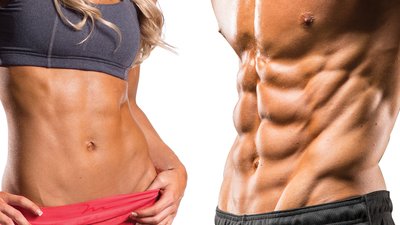If you have the goal of getting a set of six pack abs, it's not going to be enough to just do crunches in the gym and get your cardio training in. In order to really get the results you're looking for and have ripped abs - not just a flat stomach, you're going to have to be carefully monitoring your diet intake.
Many people hate the idea of strictly watching the foods they consume on a day-to-day basis, but you really must assess how badly you want a six pack. The vast majority if us simply do not have good enough genetics that we can eat with abandon and still maintain our abs, so dietary control is vital.
There are a variety of different fat loss diets available today, many of which will work perfectly fine for losing the stubborn weight that's been clinging to your body over the years. The problem you're likely going to run into though is the fact that while these diets will help you lose weight, they may not be formulated exactly to allowing you to get a six pack.
A really lean six pack is going to require much lower body fat levels (typically in the range of 5-12% depending on the person), which takes time, dedication, and commitment to reach.
You're going to have to diet harder than you did before, cycle carbohydrates to ensure that your metabolism doesn't slow down and energy levels plummet, and do more tracking than you might be used to.
Luckily, the following six pack abs diet makes things easier. While you will have your own individual preferences you should at least consider this approach. It will work well for most people when it comes to bringing body fat levels lower to reach the six pack stomach goal.
Calorie Intake
The very first thing you need to get straight to lose fat is making sure you're taking in an appropriate amount of calories. While you may have lost weight at a moderately low intake, now you're likely going to have to take this one step further.
There are many fancy metabolic calculators available today that you can use to help assess what your intake should be, but generally speaking, a pretty safe bet is somewhere around ten calories per pound of body weight. This will definitely be classified as a lower calorie diet, but it will get the results coming.
Combined with periods of overeating (more on this later), you should be able to keep your metabolism higher and prevent muscle mass loss from taking place.
Some people may be able to get lean around 11-12 calories per pound, but usually these are those who have more active lifestyles and aren't sitting as much during the day.
Protein Intake
Next up you need to set your protein intake. Ideally you should be taking in 1.5 grams per pound of body weight to really ensure you don't lose any lean muscle mass. Since as you get leaner you're at a higher risk for using up muscle as fuel, you want to provide your body with a little extra protein so if it does turn to some for fuel, it won't hinder your progress.
In addition to this, since protein is the most satisfying nutrient, you aren't going to see as much hunger when dieting if your intake is up higher.
How many meals you want to divide the protein up into is your decision. I'd advise somewhere between four and six, but some of you may prefer three meals a day, which is fine provided you're meeting your daily calorie and protein needs.
Also be sure you're having at least 20 grams of protein before training and 20 grams after. Again this is to help with the recovery process and prevent muscle mass loss.
Carbohydrate Intake
Your carbohydrate intake is what will get changed the most when moving to an intense six pack ab diet. Since you want to maximally control insulin levels and prevent hunger, your carbohydrate intake for this diet will be pretty limited to right around your training. This will also help to keep bloat (which is often accompanied by higher carb diets) down, and bring out abdominal definition.
What you will do is take your weight and divide it in half. This is how many grams of carbohydrates you're going to have around the workout, with half coming before and half coming after. So for example, if you weigh 140 pounds, this is 70 grams total, with 35 before and 35 after.
In addition to this, you can have vegetables throughout the day according to your hunger levels. Typically you don't have to track these too much provided you're staying away from the ones that are most starchy such as carrots, corn, and peas.
Fat Intake
Finally, you have your fat intake. While fat will be limited too, small amounts are important for proper functioning and to prevent you from becoming overly ravenous. To get your fat intake for the day, multiply your body weight by 0.2 and that's how many grams you should aim to get. Spread this out between your meals (apart from the pre/post workout meals).
If you follow these specifications, you should arrive at a calorie intake of approximately 10 calories per pound, which is precisely what we were aiming for as stated under the calorie intake section.
The Overeating Phase
Finally, we come to everyone's favorite phase on a strict diet, planned overeating. Taking a day or two and bumping up your calories significantly is going to help prevent your metabolism from crashing, so it's something that's very important you do regularly.
How frequently you do this overeating phase will depend upon your current level of leanness. The closer you become to getting really ripped abs, the more frequently you need to be overeating. For a male under 10% (female under 15%), you should be overeating about once a week. For those who are over this, once every 2-3 weeks should be sufficient.
When it comes to the actual overeating, you generally want to relax your calorie counting to give your mind a break. Just aim to eat a high volume of carbohydrate, lower fat foods for one full day.
Carbohydrates are going to have the greatest influence on the thyroid hormone, which is what will boost the metabolic rate the most, getting you the results you're looking for. It's when this hormone starts to drop in the body that you see the greatest negative implications with your progress.
Fat should be kept to a minimum on this day for the simple reason that when coupled with a higher carbohydrate intake, it may become very easy to take in an abnormally high calorie intake and experience fat gain. By keeping fat lower, you'll maximize the metabolism boost, refill the muscles with muscle glycogen, and get the best overall results.
Conclusion
So, if you're looking to take your fat loss to the next level, calculate out your diet so you can be sure you're doing the right thing. Taking a guess and test approach in terms of your calorie intake is much more likely to lead to a lack of results.

